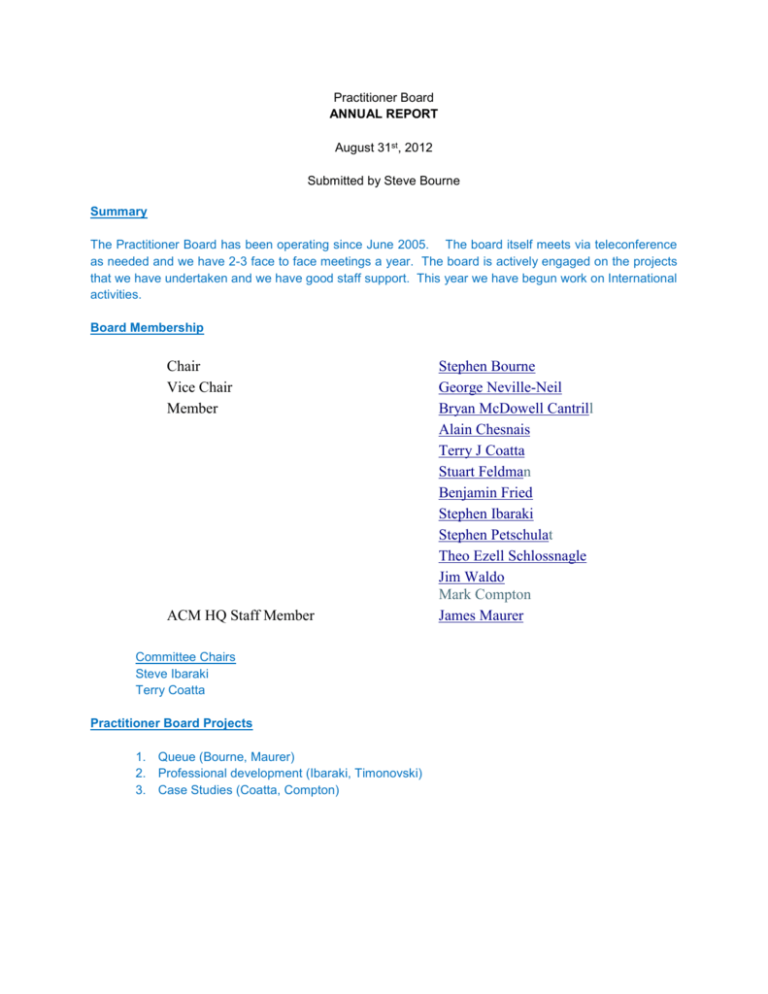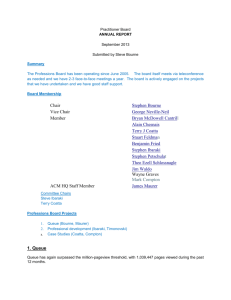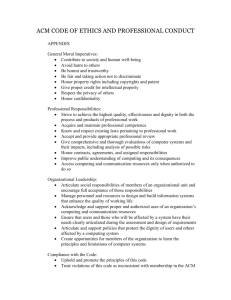FY 2012
advertisement

Practitioner Board ANNUAL REPORT August 31st, 2012 Submitted by Steve Bourne Summary The Practitioner Board has been operating since June 2005. The board itself meets via teleconference as needed and we have 2-3 face to face meetings a year. The board is actively engaged on the projects that we have undertaken and we have good staff support. This year we have begun work on International activities. Board Membership Chair Vice Chair Member ACM HQ Staff Member Committee Chairs Steve Ibaraki Terry Coatta Practitioner Board Projects 1. Queue (Bourne, Maurer) 2. Professional development (Ibaraki, Timonovski) 3. Case Studies (Coatta, Compton) Stephen Bourne George Neville-Neil Bryan McDowell Cantrill Alain Chesnais Terry J Coatta Stuart Feldman Benjamin Fried Stephen Ibaraki Stephen Petschulat Theo Ezell Schlossnagle Jim Waldo Mark Compton James Maurer 1. Queue Queue has again surpassed the million-pageview threshold, with 1,129,817 pages viewed during the past 12 months, compared with 1,082,118 last year. We're also seeing an increase in the length of time readers are spending on the site. The number of pages viewed during a visit and the amount of time spent on the site are both up between 2 and 5 percent. --Queue has been getting more attention through “social media” sites Hacker News (news.ycombinator.com) is now the biggest referring site by volume (after several years of Slashdot having this distinction) and it is driving 51.49% more visitors to Queue than last year. The following 5 articles got the most traffic from Hacker News Kamp Aug12 A Generation Lost in the Bazaar Heer Feb12 Interactive Dynamics for Visual Analysis Minsky Sep11 OCaml for the Masses McKusick Sep12 Disks from the Perspective of a File System Green Nov11 Coding Guidelines: Finding the Art in the Science Reddit is now the #2 referring site, although it has not delivered as many readers as last year. Slashdot has historically been the most important source of visits, and although Hacker News and Reddit are currently driving more readers, Slashdot remains an important source of visitors, sending 72,140 to Queue in the past 12 months. And Twitter is also an increasingly important source of traffic, with over 30,000 visits coming from there, up from less than 2,000 last year. Wikipedia remains a significant source of readership and traffic from there is up 20%. While the above four sites guide readers toward newer content, Wikipedia is the primary source of traffic to older Queue content. Facebook is another increasingly important source of traffic and visits from there is up 65.61% --Queue had 19 columns and articles get over 10,000 reads in the past year. Last year only 13 had that distinction. The year before, only 9 did so. It's clear that Queue content is having more of an impact in the community than ever. Below are the 16 articles (including case studies) that were read at least 10,000 times in the past year: VIEWS AUTHOR DATE TITLE ------ ---------- ----52,970 Minsky Sep11 OCaml for the Masses 45,060 Heer Feb12 Interactive Dynamics for Visual Analysis 34,082 Green Nov11 Coding Guidelines 30,072 McKusick Sep12 Disks from the Perspective of a File System 22,254 Nichols May12 Controlling Queue Delay 20,164 Heer May10 A Tour through the Visualization Zoo 19,320 Danowitz Apr12 CPU DB: Recording Microprocessor History 19,173 18,829 13,834 13,319 12,671 11,022 10,991 10,116 10,012 Gettys Nov11 Bufferbloat: Dark Buffers in the Internet Meijer Mar11 A co-Relational Model of Data for Large Shared Data Banks Meijer May08 The World According to LINQ Pritchett May08 BASE: An Acid Alternative Gettys Dec11 BufferBloat: What's Wrong with the Internet? Rizzo Jan12 Revisiting Network I/O APIs: The netmap Framework Flatt Nov11 Creating Languages in Racket Crandall May12 Modeling People and Places with Internet Photo Collections Pulli Apr12 Realtime Computer Vision with OpenCV And the following five columns from Poul-Henning Kamp also had at least 10,000 reads in the past 12 months VIEWS TITLE ------- ----100,049 A Generation Lost in the Bazaar 21,004 The Most Expensive One-byte Mistake 19,581 LinkedIn Password Leak: Salt Their Hide 14,595 The Software Industry IS the Problem 11,273 You're Doing It Wrong --Queue began testing a new video interview model. As print interviews have been one of queue’s most popular items, we are moving those to a video presentation format which we expect to do even better than the text format. Three queue board members—Bryan Cantrill, Ben Fried and Theo Schlossnagle—worked with ACM’s marketing department to create a practitioner-oriented “Why Join” video segment that is now in use on the queue site as well as on some other ACM sites. In early summer we did some A/B testing on a registration scenario for the queue website. Of the challenged group, only 10% actually clicked past the blurb and signed in and so we stopped the process. However, one interesting stat that resulted had to do with known IP traffic vs. unknown IP traffic. In the DL, articles are downloaded 70% of the time by known sites, (Institutions or Corporations with DL subscriptions). On the Queue site known traffic only came from 12% of the total. This really confirmed that the audience looking at Queue is different from that in the DL. Lastly, work is underway on a queue mobile presence. 2. Professional Development Committee Composition Stephen Ibaraki (Chair) David A. Black Stephen Bourne Netiva Caftori Robert Y. Chu* Terry J. Coatta Michelle Cross* Bradley Jensen Terence W. Linkletter Joyce Currie Little Srikantan Moorthy Eileen Smith William H. Tetzlaff Will Tracz Yan Timanovsky (ACM HQ) In FY 2011-12, the ACM PDC made major strides, adding new members (marked by *), launching new products and setting an ambitious agenda. Highlights: A. New Webinar Program B. New e-learning offerings (books, videos, courses) C. Tech Packs D. Learning Paths & Video Tutorials E. Podcasts A. ACM Learning Webinars In January 2012, ACM launched its webinar program with a pilot. It has been a major success in both engaging members in ACM’s learning activities, attracting new member prospects and educating over two million non-members on ACM value and ACM brand significance. The following initial parameters were set: • Free to all (members & non-members), both live and on-demand (recording) • Currently bi-monthly • 60 minutes, slides w/voiceover, moderated Q&A • Tailored to practitioners (especially developers/engineers) but attended by all • Hot topics/well-known subject experts, vendor-neutral, moderated by SIG members/officers • Broad, high-level topics but may expand to more technical, “deep-dive” events ACM launched its webinar program with a pilot. 2 presenters from Microsoft Research participated and Dave Johnson, past chair of SIGMOBILE, moderated. • Pilot (Smart Devices/Cloud Computing) – 4765 registrants, 816 live attendees, 981 on demand, 36% total attendance – 1400 non-member prospects (asked for membership materials) – 54% Practitioner, 18% Student, 28% Researchers & Educators – 68% Software/Systems Developer/Engineer/Architect, 15% Technical Managers – 55% North Americans, 28% Europeans – 85% of survey respondents found it useful, 44% very or extremely useful • Webinar 2 (Cybersecurity) – 4,000 registrants, 749 live, 1360 on demand, 51% total attendance – 64% North Americans, 22% Europeans – 60% Practitioner, 27% Student, 13% Educators – 48%% Software/Systems Developer/Engineer/Architect, 12% Researchers, 10% Technical Managers – 63% North America, 22% Europeans – 91% of survey respondents found it useful, 53.3% very or extremely useful • Webinar 3 (Business Intelligence/Big Data) As of 7/6/12, 3700 registrants, 843 live attendees, 964 on-demand, 47% attendance, 97% satisfaction rate B. New E-Learning Offerings Another major new addition was 130+ online books from Morgan Kaufmann & Syngress, available for all members. They are served through the ACM Digital Library but also available in our Learning Center. Total books/videos now 1300+ (Professionals) and 630+ (Students) Book Usage (6/1/11-5/31/12) Books 24x7: 19,498 (70% professionals and 30% students) Safari: 15,889 (professionals only) After an acquisition of Element K by SKillosft, ACM is switching from Element K to Skillsoft Courses. Skillsoft offers a leaner, more current and targeted package: 500 courses, many top vendor certificationtrack with e-mentoring (expert support). Courses will be integrated with Books 23x7 titles on the same platform. C. Tech Packs Live (updates in progress) • Cloud Computing (now version 2.0) • Parallel Computing • Enterprise Architecture • Mobility • BI/Management (New!) Tech Packs In Development • Security • Big Data • AI: Machine Learning • Bioinformatics • Social Networking • Enterprise Architecture 2.0 D. Multimedia, Learning Paths, etc. Currently piloting popular DL videos (conference keynotes, tutorials, etc.) in Learning Center for members who don’t have DL. Plan to pilot conference video capture (“ACM Tutorials) at SIGSOFT conference in November. Learning Paths Live: Python, Ruby. Planned: JavaScript, iOS Programming Podcasts w/industry leaders (done by Stephen Ibaraki). Includes Judea Pearl, Terry Coatta, TP & LP authors, etc. E. Other Developments Formation of 2 subcommittees—Webinar Subcommittee (PDC-W) and Professionalism and Certification Committee (PCC). PDC-W advises ACM on webinar content, speakers, and strategy and consists of: • Stephen Ibaraki (Chair) • Scott Delman (ACM Director of Pubs/DL; advisor) • Tan Moorthy • Yan Timanovsky (ACM HQ) • Will Tracz The PCC is charged with scanning the computing professionalism, licensing, and certification landscape for important new developments so ACM is prepared to act if necessary. Its consists of: • Stephen Ibaraki (Chair) • Bradley Jensen • Joyce Currie Little • Terry Linkletter • Yan Timanovsky (ACM HQ) 3. Case Studies The Case Study Steering Committee currently consists of: • Terry Coatta (committee chair) • Mark Compton • Steve Bourne (ICON Ventures) • Jim Gettys (Alcatel-Lucent Bell Labs) • Becky Bace (Infidel, Inc.) • Harry Saal (founder, Network General) • Amer Diwan (Google) • Tom Limoncelli (Google) • Meadhbh Hamrick (consulting software architect) • Eileen Smith (University of Central Florida) Two case studies were published over the course of the past year, and a third is in the late stages of the development process. The first of these considered the latency and jitter effects that excessive buffering in network devices is now causing out at the edges of high-bandwidth networks while also raising questions as to the stability of the Internet itself. The discussion participants featured in that case study were Vint Cerf, Van Jacobson, Jim Gettys, and Nick Weaver. A second case study that’s about to post on the Queue website focuses on Resilience Engineering — specifically, the GameDay Exercises mounted at Amazon, Google and Etsy as part of an effort to proactively test organization resilience in the face of unanticipated service disruptions. A third case study that’s late in its production cycle is concerned with Browser Security or, more accurately, the myths of browser security and the false hopes that have been pinned upon HTML5. The participants in the discussion at the heart of that case study are Jeremiah Grossman (WhiteHat Security), Ben Livshits (Microsoft Research), Becky Bace (Infidel), and George Neville-Neil. Five additional case studies are currently in the works. One considers the effort to rewrite LinkedIn’s mobile services in Node.js. Another will look at automated QA testing at Electronic Arts and considers some of the advantages MVVM-like architectures seem to offer. A third is to dwell on some of the hazards associated with using the “Infrastructure as Code” approach to configuration management. A fourth will consider the possibilities of programmable networking, courtesy of OpenFlow, with reference to Google’s corporate WAN. And a fifth will consider HTML5 deployment efforts at Pandora. Moreover, the case study program recruited and developed five articles to accompany the case studies published to date. Each of these five articles has appeared in CACM as well as on the Queue website, and two have been Slashdotted.






